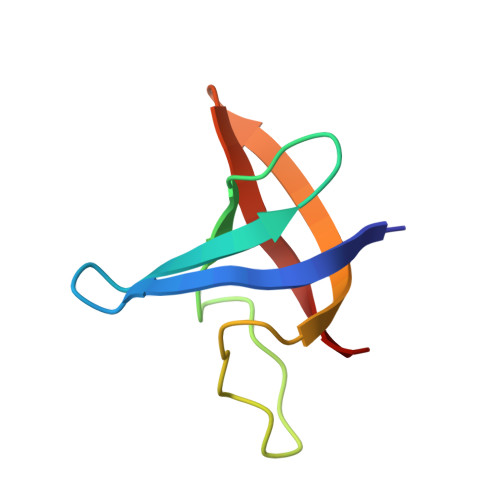Structural and Dynamic Features of Cold-Shock Proteins of Listeriamonocytogenes, a Psychrophilic Bacterium
Lee, J., Jeong, K., Jin, B., Ryu, K., Kim, E.H., Ahn, J.H., Kim, Y.(2013) Biochemistry 52: 2492-2504
- PubMed: 23506337
- DOI: https://doi.org/10.1021/bi301641b
- Primary Citation of Related Structures:
2LXJ, 2LXK - PubMed Abstract:
Cold-shock proteins (Csps), proteins expressed when the ambient temperature drops below the growth-supporting temperature, bind to single-stranded nucleic acids and act as RNA chaperones to regulate translation. Listeria monocytogenes is a psychrophilic food-borne pathogen that is problematic for the food industry. Structures of Csps from psychrophilic bacteria have not yet been studied. Despite dramatic differences in the thermostability of Csps of various thermophilic microorganisms, these proteins share a high degree of primary sequence homology and a high degree of three-dimensional structural similarity. Here, we investigated the structural and dynamic features as well as the thermostability of L. monocytogenes CspA (Lm-CspA). Lm-CspA has a five-stranded β-barrel structure with hydrophobic core packing and two salt bridges. When heptathymidine (dT(7)) binds, values for the heteronuclear nuclear Overhauser effect and order parameters of residues in surface loop regions near nucleic acid binding sites increase dramatically. Moreover, Carr-Purcell-Meiboom-Gill experiments showed that slow motions observed for the nucleic acid binding residues K7, W8, F15, F27, and R56 disappeared in Lm-CspA-dT(7). Lm-CspA is less thermostable than mesophilic and thermophilic Csps, with a lower melting temperature (40 °C). The structural flexibility that accompanies longer surface loops and less hydrophobic core packing and a number of salt bridges and unfavorable electrostatic repulsion are likely key factors in the low thermostability of Lm-CspA. This implies that the large conformational flexibility of psychrophilic Lm-CspA, which more easily accommodates nucleic acids at low temperature, is required for RNA chaperone function under cold-shock conditions and for the cold adaptation of L. monocytogenes.
Organizational Affiliation:
Department of Bioscience and Biotechnology, Bio/Molecular Informatics Center, Konkuk University, Seoul 143-701, South Korea.














